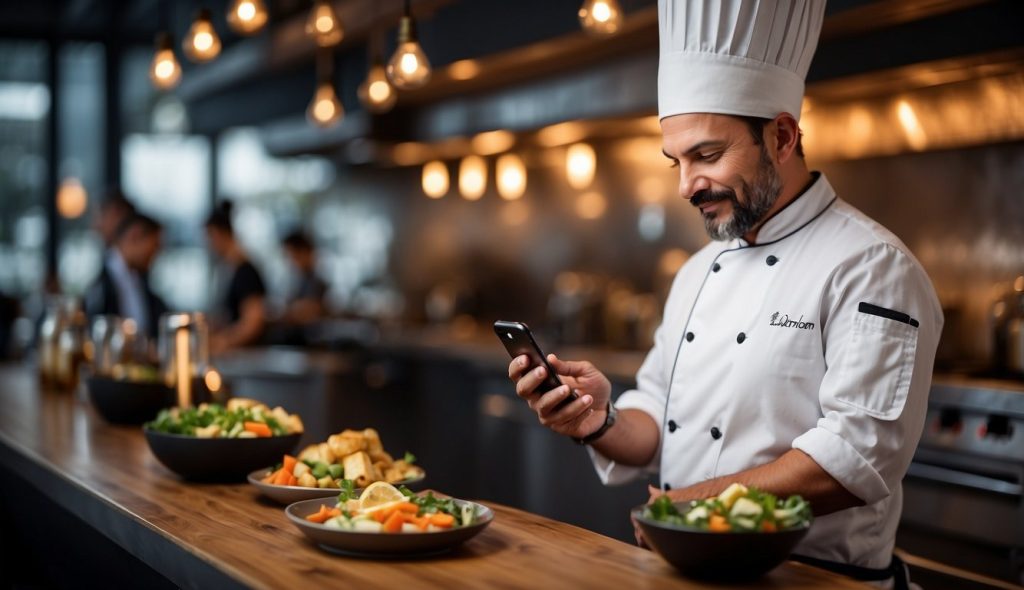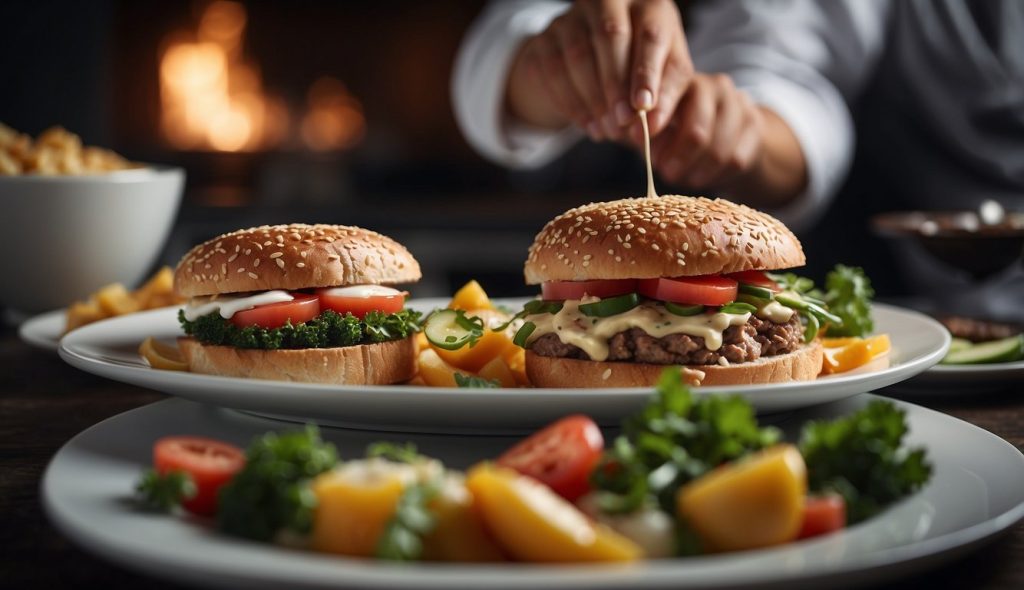In today’s digital age, social media marketing for restaurants is more than just a trend; it’s an essential component of any successful marketing strategy. With billions of users across various platforms, it offers a vast arena for restaurants to showcase their culinary creations, share their unique atmosphere, and engage with current and potential customers. Whether it’s Facebook, Instagram, or Twitter, your restaurant’s presence on these platforms can significantly elevate your brand’s visibility and desirability, provided you navigate the social media landscape effectively.

Building a solid online presence requires a tailored approach that resonates with your target audience. It’s not just about posting appealing images of your dishes; it’s about crafting a persona for your restaurant that customers can relate to and want to engage with. Strategically managing your promotions, sparking conversations around your brand, and building a community are just as important. By doing so, you can transform casual browsers into loyal patrons. Moreover, analyzing insights gained from social media can guide the growth of your business, ensuring that every post contributes to your restaurant’s success.
Key Takeaways
- Social media is a critical marketing avenue to boost restaurant visibility and engagement.
- Effective social media strategy combines brand persona with targeted promotions and community building.
- Insights gained from social media activity are invaluable for informing business growth strategies.
Developing a Social Media Strategy for Restaurants
Embarking on social media can transform your restaurant with the right strategy. By understanding your audience and setting clear goals, you’ll be better positioned to choose platforms and create resonant content.
Understanding Your Target Audience
Identify your potential customers by analyzing demographics, preferences, and behaviors. For example, if your restaurant is in a tourist area, you’ll want to tailor your content to appeal to tourists looking for a unique dining experience.
Setting Clear Marketing Goals
Before posting, specify what you want to achieve with your social media strategy. This could be increasing brand awareness, boosting customer loyalty, or driving more foot traffic.
Choosing the Right Social Media Platforms
Not all platforms are created equal. Select platforms where your target audience is most active. Instagram and Facebook are essential for visuals like photos of menu items, while Twitter may be better for real-time updates and TikTok or Instagram Reels for trendy visuals.
Crafting a Content Plan
Plan a diverse content strategy that showcases menu items, daily specials, and behind-the-scenes content. Utilize hashtags and Instagram Stories, and encourage user-generated content to engage your audience.
Metrics and Performance Analysis
Use data to track engagement and followers’ growth. Tools integrated within social media platforms can help analyze the performance of different content types.
Adjusting the Strategy Based on Feedback
Regularly review feedback and online reviews to adjust your strategy. Positive social media feedback can inform the type of content you continue to produce or prompt changes to improve customer satisfaction.
Crafting Your Restaurant’s Social Media Presence
Creating a vibrant social media presence is crucial for your restaurant’s success in the digital age. Your online profiles act as the front door to your establishment for potential diners scrolling through their feeds.
Building an Appealing Profile
Your profiles across various platforms are often potential customers’ first impressions of your restaurant. It’s essential to make them count. Begin with a clear and recognizable profile picture, typically your restaurant’s logo, and a compelling cover photo that encapsulates the essence of your brand.
The bio section should briefly describe your restaurant’s unique selling points, infused with a bit of personality. Remember to include essential contact information, ensuring your social media handle is consistent across platforms.
Showcasing Your Menu
Leveraging Instagram and Facebook to highlight your offerings is a smart move. Regularly post high-quality photos and videos of your menu items. If you’ve got an updated menu or particular dishes, make these posts to entice customers.
Create a visual feast representing your dishes as authentically as possible—the more mouth-watering, the better.
Engaging With Followers
Engagement is mouth-watering in social media success. Promptly respond to comments and foster conversations to create a community around your brand. Use relevant hashtags and repost user-generated content with credit to encourage more interaction.
Encourage your followers to share their experiences by tagging your location, using your official hashtag, or mentioning your handle—this helps to amplify your online presence through organic, customer-led communication.
Promoting Your Location and Ambiance
Your physical location and the ambiance you offer are a significant part of your brand’s appeal. Use visual content like photos of your space, behind-the-scenes clips, and customer experiences to showcase your establishment’s vibe.
Location tags in your posts also help potential customers find you more efficiently, and attractive visuals can draw in local foot traffic—people love to visit places that look great on their social media profiles.
Leveraging Content Marketing on Social Media

As you dive into social media marketing for your restaurant, the content you create and share becomes a cornerstone of your strategy. It’s your digital platter to showcase what makes your eatery unique, so let’s break down the types of content that resonate with your audience and content that encourages them to engage and share.
Creating Quality Content
Quality content is vital—it’s the backbone of your online presence. First, focus on photos and videos of your mouth-watering dishes; visuals are more likely to be shared. Remember, the hashtag #food is your ally. Use it to sprinkle a flavor of discovery across social media platforms, enticing food lovers while boosting your restaurant marketing efforts.
Sharing Behind-the-Scenes Peeks
Give your followers a savory glimpse of the behind-the-scenes action. Introduce them to your dedicated staff members and let them witness the kitchen’s hustle or the careful crafting of new dishes. This type of user-generated content adds authenticity and puts a face to your brand, adding a personal touch that guests appreciate and remember.
Utilizing Influencers and Reposting
Tapping into social media influencer networks can dramatically amplify your reach. When influencers share your quality content, it’s like a personal endorsement. Be open to reposting user-generated content as well. It’s a nod of appreciation to your patrons and shows potential customers that your restaurant is worth a visit.
Hosting Competitions and Contests
Engage your audience with interactive competitions and contests. Offering gift cards, special offers, and other incentives is a great way to encourage participation. Whether it’s a challenge to create a unique dish with your ingredients or a photo contest using a specific hashtag, competitions catalyze customer interaction and content creation.
Managing Promotions and Advertising
When embarking on promotions and advertising for your restaurant, it’s crucial to understand the best practices to engage your customers and maximize your returns. Tailoring your approach to each platform, especially on social media, can help you effectively leverage your promotions and advertising campaigns.
Advertising Offers and Specials
One of the most engaging ways to attract customers is by advertising your special offers on your restaurant’s Facebook page or other social media profiles. Highlighting exclusive deals like “Two for One Tuesdays” or limited-time gift card bonuses can create a buzz. Remember to make your promotional posts visually appealing and time-sensitive to induce urgency. For instance:
- Monday Madness: 50% off appetizers
- Weekend Wine Down: Complimentary dessert with wine purchase
- Gift Card Giveaway: Buy a $50 gift card, get a $10 card free
Effectively Using Paid Social Campaigns
To extend the reach of your promotions, consider investing in paid social campaigns such as a Facebook ad. These targeted ad campaigns should be strategic, focusing on your local area and peak dining times. Your ad campaigns aren’t just about broad visibility—they’re about reaching the right people with enticing offers that feel personalized. Here’s a snapshot format for your paid campaigns:
- Select your objective: Increase visits to your website or drive foot traffic to your establishment.
- Define your audience: Target based on location, interests, and dining habits.
- Set your budget: Control how much you spend daily or throughout the campaign.
- Create compelling content: Use high-quality images and clear calls-to-action such as “Book Now” or “Get Offer.”
By efficiently managing organic posts and paid advertising, your restaurant can create a solid social media presence that drives promotions and boosts customer engagement.
Encouraging User Engagement and Community Building
Creating a sense of community and engaging with your audience on social media platforms can significantly enhance your brand’s presence and customer loyalty. By fostering a welcoming environment that encourages interaction, you’ll be able to cultivate a dedicated customer base that not only frequents your restaurant but also champions it online.
Fostering User-Generated Content
Encourage diners to share their experiences by creating an official #food hashtag. Feature user-generated content on your profiles to show appreciation and convince more followers to post about your restaurant. Reposting customer photos and videos regularly validates their effort and contributes to your online presence.
Hosting Online Events
Contests and live videos can create buzz and maintain high levels of engagement. Organize online events where customers can win incentives, perhaps a free meal or discounts, ensuring that these events align with your brand’s image. Live Q&A sessions can also foster real-time communication with your customers.
Responding to Comments and Feedback
Always take the time to respond to comments and feedback. Whether positive or negative, show that your business values customer input by maintaining open communication with customers. This professionalism not only boosts customer loyalty but also reinforces your legitimacy.
Enhancing Customer Relationships
Developing solid relationships through social media requires personalized communication. Address your followers by name, celebrate their special occasions, and offer exclusive content that makes them feel part of your restaurant’s family. This personal touch goes a long way in solidifying customer loyalty.
Recognition of Loyal Customers
Acknowledge your regular visitors by featuring them in your posts or stories and considering a loyalty program that rewards engagement. This kind of recognition helps form a connection and encourages others to engage in hopes of receiving similar treatment.
Managing Public Relations and Addressing Issues
Maintain a thoughtful approach when managing your brand’s image and addressing public concerns. Monitor your reviews diligently and deal with any issues promptly and professionally. Always aim for resolutions that showcase your restaurant’s commitment to customer satisfaction. This aspect of engagement is crucial for building trust and a strong community.
Analyzing Social Media Insights for Business Growth
To drive your restaurant’s growth, it’s crucial to understand the treasure trove of data available through social media insights. You can fine-tune your marketing approach for maximum impact by dissecting metrics and customer behavior.
Tracking Metrics for Engagement and Reach
To kickstart your journey into social media analytics, begin by tracking core metrics. Keep an eye on the number of likes, shares, and comments on your posts to gauge engagement. Utilize a robust social media management tool to monitor the reach of your posts, which encapsulates how far your content is spreading and who it’s touching. This data can provide insights into what piques your followers’ interest most.
- Likes/Reactions: Total count per post
- Comments: Number and sentiment
- Shares: Frequency and spread
- Reach: Unique users who have seen the post
- Impressions: How often the post was displayed
Emphasis on real-time data will help you to identify trends and peak activity times.
Understanding Customer Behavior
Understanding customer behavior on social media helps tailor your marketing strategy. Dive into demographics and location data to clearly understand your customer base. This data enables you to grasp who your customers are and what they want, pivotal to shaping the dining experience they’re searching for.
Bolden your approach by analyzing:
- Click-through rates: Are customers intrigued enough to learn more about your restaurant?
- Demographic data: Age, gender, location, and even language preferences of your audience
- Post engagement timelines: Pinpoint when your audience is most active online
Leveraging Analytics to Refine Strategy
With valuable insights, leverage this knowledge to refine your social media strategies. Compare engagement numbers against previous periods to measure the success of your content over time. Identify which types of posts resonate and adjust your content accordingly.
Consider this:
- Create more food-centric content. Engagement rates are high on posts featuring your menu.
- Promotions and targeted ads can influence purchasing decisions, so analyze the conversion rates.
- Regularly update demographic information to target your advertising across the ever-changing online world.
Employing the right social media tools gives your food venture the competitive edge it deserves. Use the resources at your disposal to evolve and grow in the bustling landscape of restaurant marketing.
Integrating Social Media with Other Marketing Efforts
To harness social media’s potential effectively, ensure it works harmoniously with your broader marketing strategy. Establishing a cohesive brand voice across all channels is vital for boosting communication and reinforcing brand awareness.
Cross-Promoting Between Platforms
Leverage the power of cross-promotion to maximize your reach. Mention your Instagram specials on your Twitter feed or share your Facebook events on LinkedIn. By interlinking your social media profiles, you encourage your followers to connect with your restaurant’s online presence on various platforms.
Linking to Your Restaurant’s Website
Your website is the pillar of your online presence. Please include a clear link to it on all your social media profiles and reciprocally showcase your social media feeds on your site. This bolsters your branding and ensures your contact information and story are just a click away from your audience.
Synchronizing Menus and Promotions
Keep your online platforms in sync with an updated menu and current promotions. Share your specials on social media to entice visitors and update your website simultaneously. This aligns your marketing strategy and avoids customer confusion, reinforcing a cohesive brand voice.
Collaborating with Local Businesses and Events
Embrace the power of collaboration and link your social media strategy to community engagement. Partner with local events or businesses and share each other’s content. This increases your brand awareness and plants your restaurant firmly within the local community.
Social Media Marketing For Restaurants – Frequently Asked Questions
In this section, you’ll find answers to common questions about leveraging social media to grow your restaurant’s presence and connect with more diners.
What are some successful social media marketing strategies for restaurants?
Successful strategies include creating a consistent posting schedule, sharing high-quality images of your dishes, and engaging directly with your followers by responding to comments and messages. Implementing social media promotions and contests can also be effective.
Could you provide examples of effective social media campaigns for restaurants?
Effective campaigns often involve user-generated content, such as encouraging customers to share their dining experience with a specific hashtag or hosting a photo contest. See A Guide To Social Media For Restaurant Marketing for more ideas.
Which social media platforms are most effective for promoting my restaurant?
The best platforms for your restaurant may vary, but visually oriented platforms like Instagram and Facebook are highly effective for showcasing your menu and ambiance. You might also explore platforms favored by your target demographic; for instance, younger audiences tend to be active on TikTok. More insight can be found in The Secret Recipe: Ultimate Social Media Marketing Guide for Your Restaurant.
How can I boost my restaurant’s social media engagement with customers?
To boost engagement, ask questions in your posts to encourage comments, create relatable and shareable content, and use features such as polls or quizzes on Instagram Stories. It’s also important to post when your followers are most active.
Is social media an effective tool for increasing a restaurant’s customer base?
Yes, social media is an effective tool to expand your customer base; it broadens your reach beyond your local area and helps you to connect with potential customers who otherwise might not have discovered your restaurant.
What content should I include in my restaurant’s social media posts to attract more patrons?
Your posts should include enticing images of your dishes, menus, specials or promotions, behind-the-scenes glimpses of your restaurant, and stories showcasing your values and personality. Including calls to action can also encourage patrons to book a table or order takeout. Refer to The Complete Guide to Social Media Marketing for Restaurants for content ideas.





